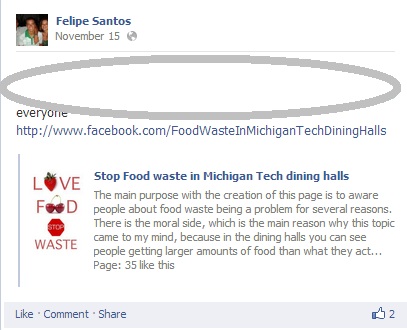In order to distribute my digital media production it is necessary to
define it as a web 2.0 element. My production is a web 2.0 artifact because it
is part of bigger web 2.0 production, something that you may have heard of
called Facebook. It allows the user to browse different profiles constantly and
watch different contents, such as images, texts and videos.
The inveracity between the users in this network is the clearest example
of why Facebook is a web 2.0 artifact. Users can spread the voice of a certain
topic, the power to connect users that are physically apart and help them to
relate as they were closer. According to Tim O’Reilly the participation of the
users in the Web 2.0 is also a main characteristic of this atmosphere. And that
is one of the advantages of a Facebook page, the users can post whenever they
want, whatever they want, start debates and express themselves. Another reason
is due to the morality of the topic. Since people are likely to participate in
“that which angers, excites, energizes, entertains, or otherwise creates an
emotional response.” (Boyd)
People are likely to be interested in this topic that involves moral response
and personal reflection.
I made a Facebook page that is focused on persuading people that
throwing food away is an issue that needs to be reduced for. One of the reasons
I chose this media is the power Facebook has to persuade and represent a
person, in this case a site, as the way the author wants it and present it in
this way to the audience. Another one is considering one article that mentions
that organizations with Web 2.0 sites are likely to succeed (Hinchcliffe) ,
because they engage with their audience in a more personal level due to the
content that they share. This page is not an organization, but making the
content available to an audience who is constantly on Facebook makes it easier
to reach the intended audience.
So the big question is how can I distribute something that is already in
Facebook? It may sound pretty easy, but it is not. Since my production is
addressed to Michigan Tech students, especially those students who constantly
eat in the different dining halls across campus, I need to have as many
contacts as possible, and that is a thing I don't have due to several reasons.
Considering that the number of students in Michigan Tech is around 7,000
students, and the 40% lives in the different residences and constantly eat in
the dining halls, we are talking about an approximate audience of 3,000
students.
The elements I am considering to reach as many students as possible
include sending constant invitations through email, an option in Facebook. I
know this may turn to be annoying at some point but it is needed. Since I’m
distributing a digital media artifact I would like to make the distribution in
the same sphere, so I’ll have to look for other options outside of Facebook to
distribute. These options include: twitter, a blog or other social network that
will reach Michigan Tech Students. The constant changes are an important part
of this Facebook page, and it will demand frequently updates. To keep the
audience with constant innovations the site will need pictures, hyperlinks to
other sites that are topic related and even videos, from my own and from
YouTube.
The advantages of using social networks are that people are involved in
an environment there are familiar with.
According to Knoke and Yang, users of social networks are guided by
their contacts activity, which means if someone becomes interested in the page,
their contacts may also be interested in this same page. In the particular case
of my Facebook page, people may become aware of my page through their contacts
who are already interested.
It is important to use as much as possible all the elements that web 2.0
provides, use all the content available on the World Wide Web to persuade my
audience. That is the purpose of web 2.0 and that is the good use people can
give to the internet. Due to the topic of my publication, people is likely to
participate in this web content and get involved with it. People will
eventually become part of my distribution, because their activity will involve
others in the same environment. Being
able to use web 2.0 as a tool to persuade people about a certain issue is one
advantage of technology, and since I’m addressed to an audience who is familiar
with the use of web 2.0 as an important part of their life, the mere existence
of this page make is available for everybody.
Works Cited
Boyd, Danah. Streams of Content, Limited Attention: The Flow of
Information through Social Media. 17 November 2009. 10 December 2012.
Hinchcliffe, Dion. Does every organization need a Web 2.0 strategy? 9
August 2006. 14 December 2012.
Knoke, David and Song Yang. "Social network analysis 2nd
edition." n.d. Sage Publications. 13 December 2012.
O'Reilly, Tim. What Is Web 2.0 Design Patterns and Business Models for
the Next Generation of Software. 30 September 2009. 8 December 2012.

